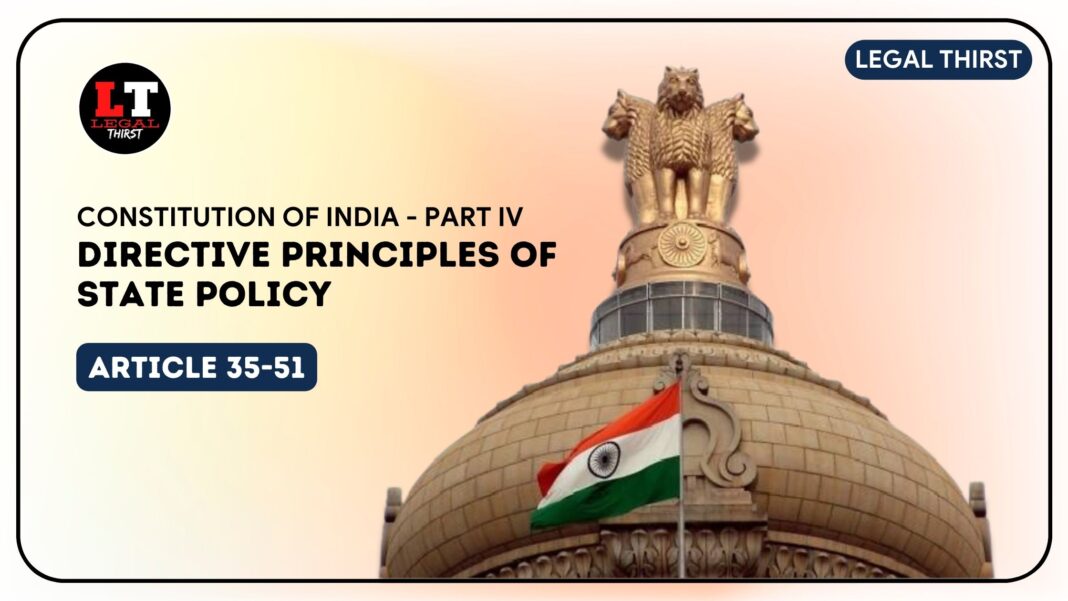Table of Contents
Abstract
Article 36-51 Directive Principles of State Policy the DPSPs contained in Part IV of the Constitution of India and dealt with the Directive Principles of State Policy (DPSP). They were borrowed from the Irish Constitution, which copied it from the Spanish Constitution. This article will only discuss Articles 36-40 under the Directive Principles of State Policy, its importance in the Indian Constitution, the 3 main principles of DPSP and some major landmark case laws.
Introduction
Directive Principles of State Policy are basically directives in the form of guidelines which are provided to the body at the central as well as the state level. These principles are non-justiciable in the court of law, but still, they are fundamentally important for the governance of the country. Directive principles of state policy are enshrined under part IV of the Indian Constitution; it has been brought up from Article 45 of the Irish Constitution. The main concept of DPSP is to create a ‘Welfare State’. It is from the Sapru Report in 1945 from which we got both Fundamental Rights (justiciable) and DPSP(s) (non-justiciable).[1]
There are three principles of DPSP
- Socialist Principles
- Gandhian Principles
- Liberal-intellectual Principles
Socialist Principles
These principles generally follow the ideology of ‘Sociology’ and establish India’s socialist framework. The state’s ultimate goal to meet the requirement of it being a welfare state is to provide social and economic fairness and justice for all of its residents. The Directive Principle of State Policy has the following articles that adhere to socialist principles: Articles 38, 39, 39 A, 41, 42, 43, 43 A, and Article 47.
Article 36[2] – It talks about the definition of the state, it is the same as given under article 12 of part III of the Indian Constitution. Basically, this article talks about the need for the state to step in and address the need for a welfare state and meet its requirements.
Article 37[3]– The application of the Directive Principles is covered under Article 37 of the Indian Constitution. The two vital DPSP elements are mentioned in Article 37, that is it is unenforceable, and they are highly fundamental and crucial for the nation’s government.
Article 38[4]– it talks about ensuring a social order that is inspired by justice and promoting the wellbeing of society. It discusses Social, Political and Economic Justice. The State must strive to advance the benefit to the people by establishing and upholding a social order where justice, social order, and economic and political, must guide all facets of national institutions.
Article 38(2)[5] – The State must work to reduce financial disparities and work to eradicate disparities in status, resources, and opportunities, not only both between individuals and groups of people who live in different places or have different occupations. It basically talks about how the state will lessen the disparities that exist between people based on above mentioned aspects.
Article 39[6]– It talks about all the policies which state must direct for its implementation for securing the need of the people
- The right to a sufficient standard of living is guaranteed to all people, men and women alike;
- The ownership and control of the material
- Resources in the society are allocated in a way that serves the common good;
- The functioning of the economic system prevents the concentration of wealth and production resources to the detriment of the general welfare;
- Men and women should be paid equally for equal work;
- That citizens should not be compelled by economic pressure, so that the strength and well-being of employees, both men and women, as well as children’s sensitive age, are not violated.
- That children are provided with opportunity and resources to grow in a healthy way, in conditions of freedom and dignity, and that childhood and youth are safeguarded against exploitation and against moral and material abandonment.
GANDHIAN PRINCIPLES
These principles reflect the ideological reconstruction of program propagated by Gandhi through national evolution. In order to fulfil his dream, some of his approaches were launched in the form of DPSP.
They order the state through these articles – article 40, article 43, article 43 B, article 46, article 47 and article 48.
Article – 40[7] talks about establishing Gram Panchayats and giving them the mandatory powers and authority to function as autonomous units. To achieve this, a third level called local government was created. In the villages, it is called Panchayati Raj. It has been established in most of the states of India.
In simple language, it says that the state should organize the Panchayat system and should grant them the mandatory powers to function as units of the self-government system.
The 73rd and 74th Amendments to the constitution concerning the Panchayati Raj and Municipal Corporations, eventually became the constitutional framework for the principle mentioned in Part V.
JUDICIAL PRONOUNCEMENTS
1. The State of Madras vs Srimathi Champakam[8]
In this case it was held that Any law that violates the guidelines outlined in Part III of the Indian Constitution will be deemed invalid, although DPSPs are exempt from this rule. This demonstrates that in this instance, fundamental rights take precedence over DPSPs.
2. Minerva Mills vs Union of India[9]
In the case of Minerva Mills vs Union of India, the Court held that there should be harmony between FR AND DPSP because neither of them has any precedence over each other. Both are complementary to each other with equal importance in the interpretation of laws and rights of the people and they should be balanced anyhow for the proper functioning of the State. and to achieve welfare state.
3. C. Golaknath & Others vs State of Punjab & Another[10]
In this case The Court observed and held that the Parliament cannot restrict fundamental rights when enacting state laws or policies. It further said that if a legislation has been created to carry out Articles 39(b) and(c) of Part IV of the Constitution and, in the course of doing so, violates either Articles 14(a), 19(a), or 31(a), the law cannot be ruled unlawful only because of the violation.
4. Ashok Kumar Thakur v. Union of India 2008[11]
In this case, the Supreme Court declared that the two rights cannot be distinguished. Fundamental rights deal with civil and political rights, while DPSP deals with social and economic rights. DPSP is unenforceable in court of law but that the does not mean that the DPSP is subordinate.
5. State of Kerala v N.M. Thomas, 1976[12]
The Supreme Court held that fundamental rights and the DPSP should be built to go hand in hand and that the court should make every effort to resolve the dispute between them.
6. Dalmia Cement v. Union of India[13]
The Supreme Court stated that the Fundamental Rights and the DPSP complement and supplement each other and that the Preamble to the Constitution introducing the Fundamental Rights, the DPSP is the Conscience of the Constitution.
7. Olga Tellis v Bombay Municipal Corporation, 1985[14]
The Supreme Court held that the DPSP is fundamental to the governance of the country and therefore should be given equal weight to the concept of fundamental rights. claimed to be.
8. Pathumma v. State of Kerala, 1978[15]
The Supreme Court emphasized the purpose of the DPSP. The purpose of DPSP is to establish several socio-economic objectives. The Constitution aims to establish a link between the DPSP and fundamental rights, which is reflected in several other cases.
9. Kesavananda Bharati vs State of Kerala and Another[16]
the Supreme Court ruled in 1973 that Parliament could amend any part of the Constitution without destroying its basic structure. Now, as you have read, the second clause of Article 31(C) has been declared unconstitutional and void because it violates the basic structure. However, the first sentence of Article 31(C) remains valid. In response, Congress introduced the 42nd Amendment Act of 1976, which expanded the scope of the provisions of Article 31(C) above.
Criticism of DPSP
● Non-enforceable:
They have been called “pious superfluities and have been likened to blank checks, New Year’s resolutions, and statements of goals and aspirations.
● Arranged illogically:
DPSP has been criticized for being structured in an illogical way and lacking a coherent philosophy.
● Conservative and Orthodox:
Some regulations are outdated and do not correspond to 21st century philosophies. Original Prohibition of intoxicating drinks
● Potential Conflict Between Centre and State During DPSP Implementation
In the early days, there were many constitutional complaints related to the conflict between the FRs and the DPSP.
Conclusion
Today, fundamental rights enjoy dominance over Directive principles. However, Directive principles can be implemented. Parliament may amend the fundamental powers to implement the Directive Principles, as long as such amendment does not damage or destroy the basic structure of the Constitution.
The DPSPs have provided an additional constitutional discourse in the protection of human rights in general and socio-economic rights in particular. With a fundamental position in the constitution, the DPSP guides the state and the people to implement socio-economic and political justice. In the process, the DPSP brings state agencies not only in line with the ideals, values, and principles of the constitution, but also makes them respond to their own actions. Adoption of the DPSP is continuously monitored by the public through periodic elections and by the courts through judicial review, which is consistent with the ideals of constitutional democracy.
References
- Drishti IAS (2021) Directive principles of state policy (DPSP), Drishti IAS. Available at: https://www.drishtiias.com/to-the-points/Paper2/directive-principles-of-state-policy-dpsp (Accessed: November 13, 2022).
- Art. 36, Const. of India
- Art. 37, Const. of India
- Art. 38, Const. of India
- Art. 38 Cl 2, Const. of India
- Art. 39, Const. of India
- Art. 40, Const. of India
- The State of Madras vs Srimathi Champakam, 1951 SCR 525
- Minerva Mills vs Union of India, 1980 AIR 1789
- C. Golaknath & Others vs State of Punjab & Another, 1967 SCR (2) 762
- Ashok Kumar Thakur v. Union of India, 1972 (1) SCC 660
- State of Kerala v N.M. Thomas, 1976 AIR 490
- Dalmia Cement v. Union of India, (1996) 10 SCC 104
- Olga Tellis v Bombay Municipal Corporation, 1986 AIR 180
- Pathumma v. State of Kerala, 1978 AIR 771
- Kesavananda Bharati v. State of Kerala and Another, 1973) 4 SCC 225
Disclaimer: The opinions and views in the articles and research papers published on this website; are personal and independent opinions of the author. The website is not responsible for them.
Legal Thirst has created a telegram group for exchanging legal knowledge, Events, and various opportunities.
You can click on this link and join:
Follow Legal Thirst on Instagram and Subscribe to our YouTube channel for more amazing legal content.



